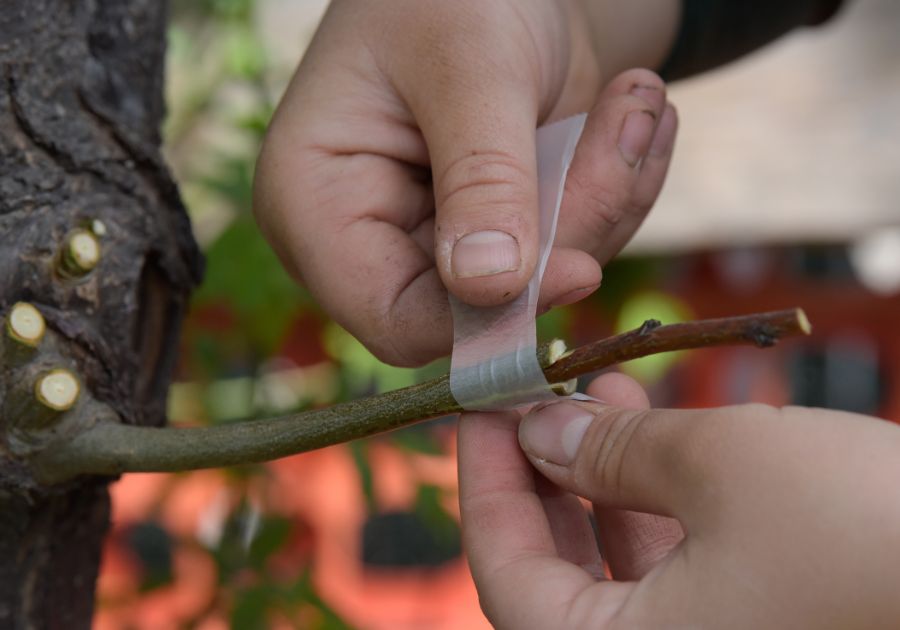Grafting 101
Grafting Fruit Trees
What is grafting?
Grafting is the process in which part of one tree is taken and attached to a different tree where it will continue to grow. Often, trees must be of the same species or genus for this to work, although grafting within the same family is also possible. I.e. we use apple rootstock for apples, and pear rootstock for pears; while there is occasionally some graft compatibility between apple and pear, it is far and few between.
Most commonly in our fields and orchards we use the following methods of grafting:
- Bench grafting: a small branch called a scion or scionwood is cut from one tree, a matching cut is made on rootstock, then they are fitted and tied together.
- Chip budding: which involves cutting the bud from one tree, making a matching cut on the rootstock, inserting the bud into the cut, then wrapping it.
- Bark Inlay: scionwood is carefully cut and shaped, then inserted directly into the bark of another tree.
.
What is scionwood?
Scionwood, or scions, are the small branches you graft with in order to propagate a variety. It is the one year growth from a tree. The scionwood is what grows into the desired variety when we are grafting! For example, if you want to grow a Pink Pearl apple tree you would collect scionwood from a Pink Pearl tree and graft it onto rootstock.
Scionwood and budwood are essentially the exact same thing, it's just a difference in time of year that they are collected/used and handling.
Where can I get scionwood?
We sell scionwood from our orchards. Generally, any tree listed on our website or in our catalogue is growing in one of our test orchards and we should be able to provide scionwood for it. We also have many other varieties (over 500 collectively) that aren’t on the website, so feel free to inquire about other varieties. Some of our trees may be too young to provide sufficient scionwood to sell however.
If you are interested in ordering, you can visit our Scionwood and Rootstock collection for more information on varieties, sizing, placing an order, etc.
We recommend placing scion orders by Jan. 31st for the spring. We generally harvest our scions in late winter/early spring depending on the weather and they are often available for shipping/pick-up earlier than our other orders. Please note that we ship scion orders in the second week of March and the second week of April at our discretion, with no delay available. If you need to hold it dormant until later in the season that is your own responsibility.
Scionwood can also be sourced from other growers (eg. Bill O’Keefe in Ontario has an excellent heritage selection) or you can harvest it yourself if you have a tree you would like to propagate!
How do I collect and store scionwood?
HARVESTING SCIONWOOD

Scionwood is best cut in late winter/early spring when it is warm enough that there is little risk of the cut suffering from freezing damage but before the trees break dormancy. You want to harvest the one year growth which is often smoother and shinier than the older growth. You should be able to see a growth collar (a small ridge around the branch) delineating the newer growth from the previous growing season. Bundle the cut scions (we use masking tape) and label immediately. Pictured to the left is Steph holding some freshly cut scions in late February, 2022.
Ideally, scionwood should be about pencil thickness, or the diameter of the rootstock so the cuts match up. You will want 2-3 buds per scion for grafting, or about 3", so if you have a scion that is 15" long, you should be able to get 4-5 grafts' worth of material. See below for a video that covers more about how to harvest and store scionwood.
STORING SCIONWOOD
Scionwood is relatively easy to store at home in the fridge (not the freezer), but you must make sure it is not being stored with any other fresh fruit or vegetables, such as apples. The fruit/vegetables will release ethylene gas that will prevent the scionwood from ever breaking dormancy.

Outside of ensuring you are not storing your scionwood in the same fridge as fruit, you should ensure it is staying moist, but not sopping wet. We store our scion in our cold-storage where it is heeled into damp sawdust or wrapped in damp newspaper and then stored inside a bag to keep the moisture in. If you purchase scionwood from us, you can store your scionwood in the packaging bag it arrives to you in. You may wish to replace the damp newspaper with a fresh layer of your own dampened paper. If so, make sure it is damp but not sopping, you don't want to cause rot! Use your scion as soon as possible, and check it regularly (weekly is good) to confirm it is staying dormant in your fridge.
Check out this video below to learn more about scion do's and don'ts from our friend and affiliate, Susan Poizner of Orchard People, and learn a bit about our Online Grafting Course as well!
A quick video summary & linked resources:
Learn about collecting and storing scionwood with Susan Poizner of OrchardPeople.com and Steph Muma of Silver Creek Nursery in this excerpt from their instant access online course Complete Fruit Tree Grafting and Budding which you can find here: https://learn.orchardpeople.com/grafting-budding-course/40qr2
🍎We do offer a few limited-capacity Workshops that happen seasonally on site here at Silver Creek Nursery, but we are not currently able to expand this area. If you are interested in premium fruit tree care education, we recommend visiting Orchard People for many offerings to suit your learning needs.
What is budwood?
Budwood is the same portion of the tree, just collected in August (for us - this may vary based on your climate), and it's used for bud grafting. We use the fresh shoots from the currant year, look for the growth collar (a ring at the base of the branch where it changes from 2 year old wood to 1 year wood). It should be around pencil thickness. Similar to scionwood, these buds determine what variety the grafted tree will be.
How do I harvest budwood?

In late summer (usually around August for us*), locate the current year’s growth on your tree. It will generally be thinner, smoother, and glossier than older growth. Cut this off the tree and cut off the youngest end, the buds here will likely be smaller and less plump since they have not matured yet and will not be as successful for chip budding. Remove the leaves but leave the stems so you have a ‘handle’ with which you can hold the hold when working with it later. Bundle the budwood (we use masking tape) and label immediately.

*Look for a slight browning of the buds under the leaf stem. Soft, green tissue is immature. For grafting we want hardened off material with a solid heartwood core, brown bark, and bit of brown to the buds we use. Some varieties are more tricky than others; Muscadet de Dieppe for example can feel hard but look very green, and that's just the nature of it! If in doubt, give the tree another week or so until you are sure the budwood is 'ripe'. But keep in mind, the trees need 15-20 days to nicely callous with warm weather, so be careful leaving it too late in the season. We like to wrap up around early-mid September, though ideally we keep it all in August, in a typical year (weather dependent).
Store the budwood in a cooler and use it for grafting within 24h. Unlike scionwood which can be stored dormant in the fridge for months, budwood quickly dries out and is no longer viable.
Check out the video below to learn about budwood collection in a more visual way from Susan Poizner of Orchard People, and hear a bit about our Online Grafting Course too!
A quick video summary & linked resources:
When are fruit tree buds ripe? And how do you collect budwood for bud grafting? Learn how in this short video with Susan Poizner of the fruit tree care training website OrchardPeople.com and Steph Muma of Silver Creek Nursery in Ontario. To learn more about our award-winning online course "Complete Fruit Tree Grafting and Budding" visit this page: https://learn.orchardpeople.com/grafting-budding-course/40qr2
🍎 We do offer a few limited-capacity Workshops that happen seasonally on site here at Silver Creek Nursery, but we are not currently able to expand this area. If you are interested in premium fruit tree care education, we recommend visiting Orchard People for many offerings to suit your learning needs.
Online Grafting Courses by Silver Creek Nursery and Orchard People
We get so many questions and comments about grafting, and our whip-and-tongue grafting course sells out so early every year, we decided to partner with Susan Poizner of Orchard People to create an online course.
Visit our Online Courses & Workshops page to learn more about this opportunity!
In-person Grafting Course at Silver Creek Nursery
Visit the event details for our on-site Grafting Workshop here, or contact us at sales@silvercreeknursery.ca to inquire about the availability of our next workshop.

Live Webinar!
On December 11th at 8pm EST, Steph Muma and Susan Poizner are hosting a free live webinar about grafting!
Are you new to grafting or looking to improve your grafting success? This webinar will cover common mistakes new grafters make - and how to avoid them! If you can't make it that night, there will be a recording available for 1 week afterwards!

Online Course: Fruit Tree Grafting
Learn how to add different fruit cultivars onto an existing tree or how to graft a fruit tree from scratch. Your teachers are Orchard People’s Susan Poizner and Silver Creek Nursery Owner Steph Muma. We are currently revamping the course to add some new content! Add your name to the waitlist for 2025:
